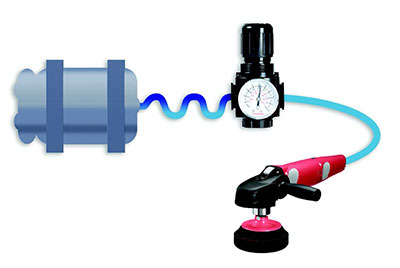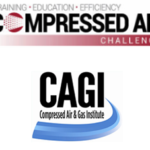Eliminating leaks, misuse, overpressurization and pressure drop can ensure efficient compressed air systems.
Contributed by Bradlee Dittmer, Product Marketing Manager, Norgren Inc., An IMI Precision Engineering-branded company
 Are your energy dollars vanishing into thin air? According to U.S. Department of Energy estimates, 10 to 30% of all energy consumed by the average industrial facility is used to generate compressed air. And a third of that air may be wasted. The potential for energy savings is clear. Making sure the compressor is performing efficiently can prevent a lot of waste, but another — often overlooked — opportunity for energy savings is the compressed air delivery system. This article describes the four most common ways air is wasted after it leaves the compressor and how to fix them.
Are your energy dollars vanishing into thin air? According to U.S. Department of Energy estimates, 10 to 30% of all energy consumed by the average industrial facility is used to generate compressed air. And a third of that air may be wasted. The potential for energy savings is clear. Making sure the compressor is performing efficiently can prevent a lot of waste, but another — often overlooked — opportunity for energy savings is the compressed air delivery system. This article describes the four most common ways air is wasted after it leaves the compressor and how to fix them.
Problem 1 – Leaks
Leaks are the main cause of energy waste in compressed air systems. The U.S. Department of energy estimates that as much as 20 to 30% of compressors’ output is wasted due to leaks.
How much are leaks really costing you? Use this formula recommended by the U.S. Department of Energy2 to find out:
(Number of leaks) x (Leakage rate in cubic feet per minute) x (Compressed air generation requirement in kilowatts per cfm) x (Number of hours per year) x (Energy cost per kilowatt hour)
Small leaks are the most common, so the following very conservative example starts with the assumption of 10 leaks at a size of just 1⁄32 in. At a pressure of 100 psi2, the leak rate would be 1.55 cfm2. Other assumptions are that the compressor requires 18 kW to generate 100 cfm of compressed air at an average cost of $0.1 per kW hour. Finally, assuming 7,500 hours of operation in a year, the potential savings are calculated:
(10)(1.55)(0.18)(7500)(0.1) = $2,090.50
That’s over $2,000 a year for just ten leaks totaling only about one-third of an inch! And the cost goes up at an exponential rate as leak size increases. Since most leaks can be repaired in a matter of minutes, most in less than an hour, the payback is nearly immediate and substantial.

So how should maintenance professionals look for leaks? Use an ultrasonic leak detector or simply listen for escaping air, starting at the compressor and walking down the line.
Leaks near the compressor are typically the costliest because that’s where the pressure is highest, but leaks there are fairly rare. More common leak sites are pipe joints, quick disconnects, flanges, condensation traps, fittings, filters, regulators and valves. Large leaks often occur at connection points in the main distribution system and in off-takes. Worn snap connectors and poorly jointed pipework can allow leaks. Leak detection fluid helps pinpoint the location by producing bubbles where air is leaking.
Air can escape through damaged or deteriorated hoses and couplings. Older pneumatic components like cylinders and regulators might have worn internal air seals that leak. Condensate drains that are stuck or left open allow large amounts of air to escape.
Finally, systems that are left pressurized when they are not in use can leak. Some subsystems like presses or drop hammers that must be kept pressurized have leakage that cannot be avoided, but waste can be minimized by isolating them from the air supply when they are not in operation. Shut-off valves or electrically operated soft start dump valves are cost-effective ways to isolate leaky systems or unused areas of a plant. And don’t forget to disconnect obsolete equipment from the air distribution system if it is not moved after being retired.
Besides wasting energy, leaks affect productivity when they cause system pressure to fluctuate. Increasing the pressure from the compressor to compensate just drives up energy use and can shorten the equipment’s service life. So, finding and repairing leaks pays off in more ways than just energy savings.
Problem 2 – Misuse
The second most common waste of energy is using compressed air just because it is available, even when there are more efficient power sources for the application. Some examples of potential misuse are creating vacuum, ejecting faulty products from assembly lines and removing water, dirt or powder. Some processes need air, but not compressed air. Dedicated air blowers or vacuum pumps may be more energy efficient. If compressed air is required, choose the correct equipment and control systems to keep usage to a minimum.

Where air nozzles must be used, for example to remove dust or powder from products moving down a conveyor, make the distance between the nozzle and the target as short as possible to keep the air pressure as low as practical. Nozzles should only be directed at the specific point where air is needed. Fit control valves and sensors to ensure that flow only occurs when the product reaches the nozzle, with no flow during gaps between the items on the conveyor or when the conveyor is not running. Air saver nozzles entrain and accelerate the air, producing higher outputs at lower supply pressures. They can reduce compressed air usage twenty-fold.
Problem 3 – Over-pressurization
Many plants run their compressed air systems at full line pressure, regulated only by the pressure switch on the compressor. But every pneumatic component or tool has an optimum operating pressure and flow. Operating all of them at mainline pressure will waste energy and shorten equipment life by increasing loading and wear. Pressure regulators allow air to be delivered to each tool at its rated pressure.
If there are no pressure regulators distributed throughout a system, it is likely that excessive pressure is being used and energy wasted. Even when pressure regulators are present, they should be checked to see that they are actually regulating the pressure. If the outlet pressure is the same as the inlet pressure, regulators are not helping save energy.
Reducing pressure on double-acting cylinders can save energy. These cylinders usually only do work on the out- or work-stroke, so the return stroke can be accomplished at a lower pressure. Using a pressure regulator to reduce return stroke pressure can have a fast payback, especially where large bore, long stroke or multiple cylinder systems are used.
To save energy with valves, reduce the applied pressure to the rated conductance of the valve. Be sure to note the valve operating duration to ensure optimal flow savings. The potential savings are small but for multiple valve installations or rapidly cycling valves with long pipe runs they can add up.
An industry rule of thumb is every reduction of 2 psig in system pressure will reduce operating costs by approximately 1%.
Problem 4 – Pressure drop

Pressure drop is the loss of power available to do the work required. Operators often compensate for this loss by increasing the pressure from the generator or by turning up regulators, but this drives energy costs up without addressing the underlying problem. The best way to save energy is to find and eliminate the cause of pressure drop at its source.
The potential energy of compressed air dissipates through friction as the air is pushed through all the components of the distribution system. In most cases, 15 psig (1 bar) of unnecessary pressure drop increases generating costs by up to 7%. The two main areas where pressure drop occurs are pipework, including tubing, and filtration.
Friction occurs between a pipe’s surface and the air molecules that pass through it. If the pipe is too small for the volume of flow, the velocity of the air will be higher, resulting in more friction and a loss in the power potential of the compressed air. Piping also causes energy loss when there is a change in flow direction, such as at elbows, junctions and shut-off valves.
Simplify pipework to avoid using elbows and fit low resistance valves. A low resistance full flow ball valve creates less resistance than a gate valve. Another way to prevent pressure drop between a valve and actuator is to use an integrated valve/actuator unit. These integrated components combine the valves, flow controls, cushioning and sensors in the same package as the actuator. This reduces or eliminates multiple valve islands, external components, tubing and accessories, so not only is pressure drop avoided, but less energy is required and there are fewer points vulnerable to leaks.

Filtration is essential to conditioning compressed air and protecting equipment from water, particles and degraded compressor oils, but a filter can impact the flow, causing pressure to drop. There are three ways to minimize pressure drop caused by filtration. First, correctly size the filter unit. As with pipework, if the filter unit is too small for the flow required it will cause a larger pressure drop. Second, use the right level of filtration. A very fine filter will create more flow resistance than a coarser filter. Most air tools only require filtration to a particle size of about 40 microns. If finer filtration is required, say, 5 microns, place the filter as close as possible to the tool requiring it rather than filtering the whole main or branch line to this level. Delivering air that is cleaner and dryer than it needs to be wastes energy.
Maintaining filters also helps prevent energy waste. After some time in service, the filter element will be blocked by particles, reducing pressure. Operators sometimes turn up the regulator to restore the pressure, but this increases energy consumption. Simple pneumatic or electrical pressure drop indicators can show when pressure is dropping, signaling that the filter element needs to be changed. Changing elements when indicated or on a regular filter maintenance schedule reduces energy consumption and ensures that the correct quality of air reaches the tool or machine.
An ounce of prevention
Good design and regular maintenance can help prevent energy waste before it happens. Properly sized pipework, filters and components like valves and cylinders make the most efficient use of compressed air. Keeping the air flowing by maintaining filters saves energy. Inspecting systems for leaks and repairing them quickly can really pay off in energy savings. And not using compressed air when other energy sources or air delivery mechanisms can do the job will cut energy use as well.
Norgren Inc.
imi-precision.com





I operate a measurement services business. Getting clients in hospital or water treatment is easy to acknowledge that air leaks are costly, but they get the avoidance virus when it comes to paying let’s say $2500 to conduct a survey to pinpoint the source! What’s missing?